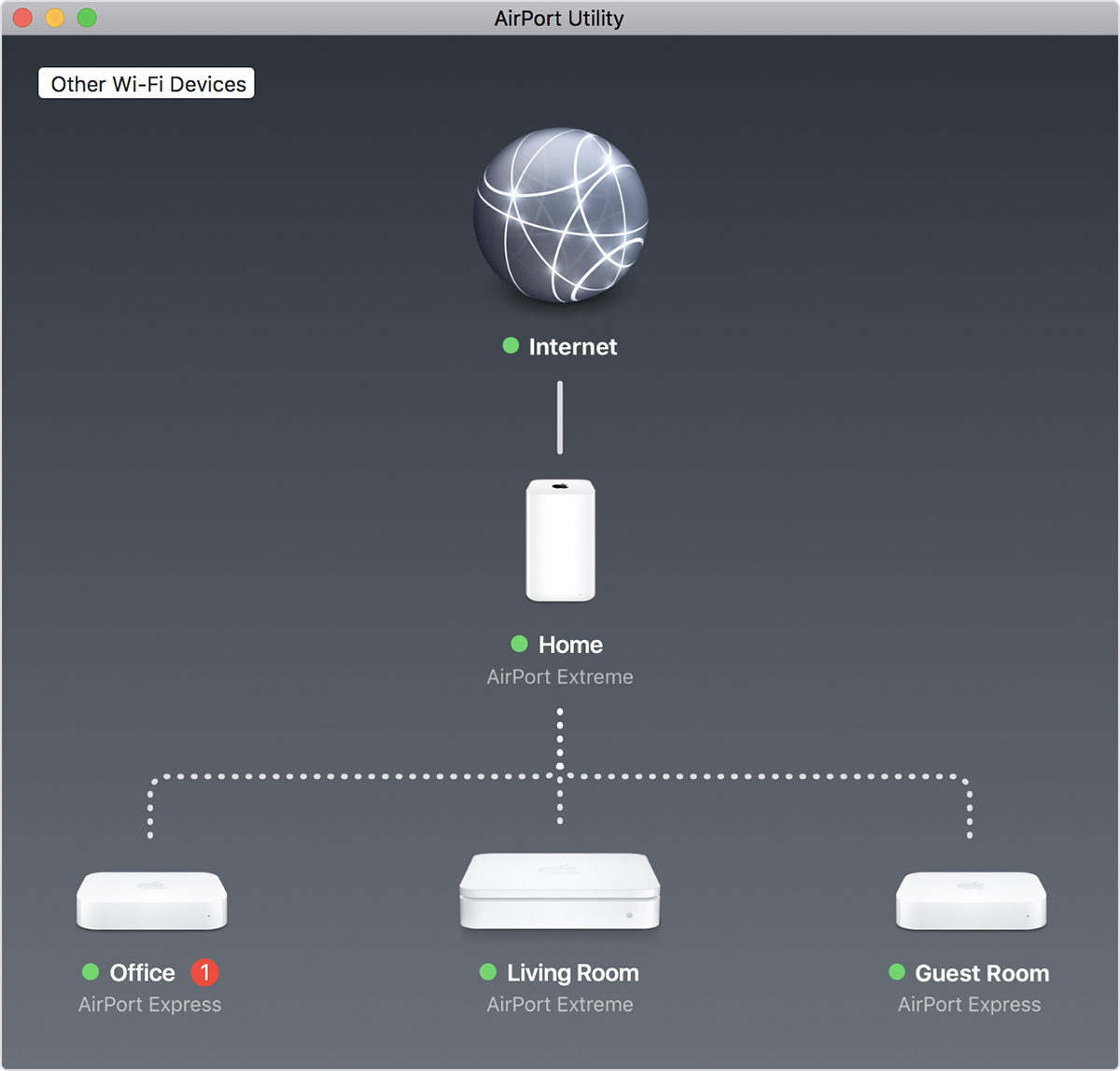
- #Airport utility setup how to
- #Airport utility setup mac os x
- #Airport utility setup mac os
- #Airport utility setup driver
- #Airport utility setup manual
#Airport utility setup mac os
–ssid= Specify SSID when creating a PSKĪs you can see, there is an abundance of options to interact with wireless networks by using the airport utility in Mac OS X. The following additional arguments must be specified with this command: P –psk Create PSK from specified pass phrase and SSID. Will perform a directed scan if the optional is provided s] –scan=] Perform a wireless broadcast scan. I –getinfo Print current wireless status, e.g. z –disassociate Disassociate from any network c] –channel=] Set arbitrary channel on the card Sudo airport en1 prefs JoinMode=Preferred RememberRecentNetworks=NO RequireAdmin=YES LogFile – Save all AirPort logs to /var/log/wifi.logĬonfiguring preferences (requires admin privileges)
#Airport utility setup driver
A debug log setting may be enabled by prefixing it with a ‘+’, and disabledĪllUserland – Enable/Disable all userland debug flagsĪllDriver – Enable/Disable all driver debug flagsĪllVendor – Enable/Disable all vendor debug flags Captures files are saved to /tmp.ĭebugĞnable debug logging. To use that channel before it begins sniffing 802.11 frames. Sniff If a channel number is specified, airportd will attempt to configure the interface Logger Monitor the driver’s logging facility. Keys and possible values are specified below.īoolean settings may be configured using ‘YES’ and ‘NO’. Preferences may be configured using key=value syntax. Prefs If specified with no key value pairs, displays a subset of AirPort preferences for If an interface is not specified, airport will use the first AirPort interface on the system.
#Airport utility setup mac os x
You can also just run ‘airport’ at the Mac OS X command line to get the full help file, shown below:
#Airport utility setup manual
While there is no manual page for the airport command, attaching the -h or –help flag to the command to will issue a brief list of flags and explanations of their function. This is easily one of the most powerful ways to interact with a wireless card on a Mac. The airport command is more powerful than just being able to list information on the current wireless network though, you can actually manually adjust any wi-fi settings, network card settings, troubleshoot networks, change security types used on a connection, capture packets into a pcap file, join and leae networks, disassociate from a wifi network, prioritize routers and networks, see signal strength and interference, adjust wi-fi hardware drivers, and perform a huge variety of network troubleshooting functions too. You can also use airport -I at the Terminal prompt, which will return information specific to the current wi-fi connection, looking something like the following:ĭisplayed is detailed information on wireless signal quality, noise, security, and other WiFi network attributes. Now that you have quick and easy access to airport with the above symbolic link, you can start using the airport tool.įor starters, you’ll probably find the -I flag and -s flags to be most useful and informative.įor example, with airport -s you will effectively have a wi-fi router stumbler and get a list of available wireless networks complete with their SSID, BSSID hardware address, security encryption type, and channel. Using the airport Wireless Tool in Mac OS X Command Line

Yes, that giant cryptic path through the depths of Mac OS X is where Apple hid the wonderful airport utility, but by running the above command you have just linked that long path to the much shorter ‘airport’, which is great.

Whichever method you go with, the sudo command will prompt you for a root password, enter it and hit return. Note the only difference between modern macOS versions and prior versions is where you will be placing the symbolic link, which is in /usr/local/bin/ versus in /usr/sbin/ $ sudo ln -s /System/Library/PrivateFrameworks/amework/Versions/Current/Resources/airport The above may be a bit hard to read on some browsers, so alternatively you can use the following (it does the same thing, just split into two commands):įor Mac OS Catalina, Mojave, and newer macOS versions Sudo ln -s /System/Library/PrivateFrameworks/amework/Versions/Current/Resources/airport /usr/sbin/airport Sudo ln -s /System/Library/PrivateFrameworks/amework/Versions/Current/Resources/airport /usr/local/bin/airportįor Mac OS X High Sierra, Sierra, El Capitan, Mavericks, and earlier Creating a symbolic link to airport is very easy, in the Terminal type the following:įor MacOS Mojave, Catalina, Big Sur, and newer MacOS releases The first thing you’ll want to do is create a symbolic link to the airport command, because it is situated in a very inconvenient location with a deep path, this helps for quick usage. First, Get Easier Access to airport Wi-Fi Tool In case you were wondering, yes the command line airport tool exists in nearly all versions of Mac OS X, even modern versions that stopped calling wireless networking ‘airport’ and refer to it as Wi-Fi.
#Airport utility setup how to
How to Access & Use airport Command Line Tool on Mac OS


 0 kommentar(er)
0 kommentar(er)
